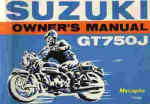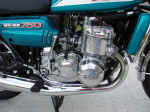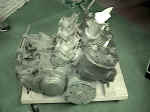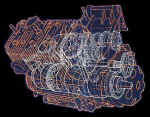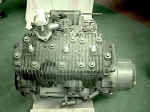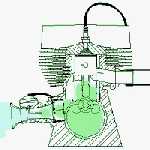Suzuki GT750/TR750 Engine
BackgroundThe Suzuki GT750 was the first production 2-stroke engine that was water cooled, and is known as the "Water Buffalo" in the US and the "Kettle" in Europe. Stock SpecificationsEngine Type: 3 cylinder, 2-stroke Displacement: 738cc Bore: 70mm Stroke: 64mm Horsepower: 52-70 HP @ 6,500 RPM which varied over the years 1971 to 1977 Torque: 8.5 Kg/m @ 5,500 RPM
GT versus TRThe Suzuki factory performed modifications that transformed the GT750 street engine into the TR750 Grand Prix racing motorcycle engine. Aside from factory porting changes, many other modifications included no fins on the barrel and head, no SRIS oil injection provisions, a 6-speed transmission (Ocelot had a few of these), and they ran a dry, air cooled clutch to save weight (DSRs ran a wet clutch). The factory 739cc TR750 GP bike made 107HP (rear wheel) @ 8,000 RPM - adding 2% for chain losses = 109 HP at the crank, or 2.44 HP/cubic inch. |
|
Ocelot SuzukiGene Davis and Larrie Schneider ran Ocelot Racing, Inc, of Madison, Wisconsin. In addition to producing the Ocelot chassis, Ocelot engineering modified over 130 Suzuki GT-750 engines over a time frame covering from the early 70s to the mid 80's. These Ocelot/Suzuki engines ruled DSR for many years, until the more powerful Kohler (140HP) came on the scene. Several DSR National Championships were won with Ocelot Suzuki engines. Note that the Ocelot made even more power than the factory TR750 due to larger carburetors and a full 750cc displacement compared to the TR's carburetor size, limited by Grand Prix rules, and 739cc displacement. Note that with the horsepower listed below, Ocelot engines put out 2.5 HP/cubic inch or 150 HP/liter in the mid 70s! OfferingsOcelot made two basic race engine types:
Modifications:Ocelot engines included these changes:
Ocelot nowLarrie Schneider has retired to Florida. Gene Davis is still in the Madison area, having sold the Ocelot business to Dan Olberg of Magnum Racing and Machining in Bloomington, MN. |
|
Notes from John McCann"My ex-Urso Ocelott/Suzuki, now with 1mm oversize pistons is at 760cc. That 71mm bore motor is really gulping... what with 40mm Lectrons Anyone know where I can get some 5mm oversize 75mm/850cc pistons?" Email: John McCann Some images provided by John McCann. Notes from Bill Meyer"I ran these engines a long time ago (when they were still competitive in DSR). [Recommended ignition changes are to:]
This setup fires each cylinder 3 times per revolution with no detrimental effects. Any electronic tachometer can be used. The tach should be set for a 6 cylinder 4 stroke to get the indicated RPM's correct (from memory, don't hold me to this without re-calculating). Standard water temperature gage can be installed in the water outlet neck." |

